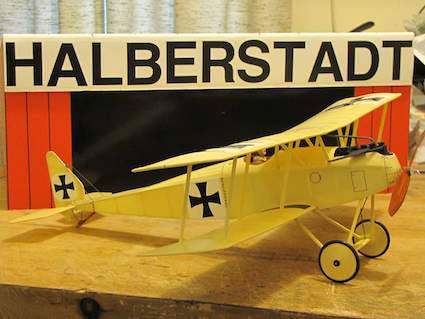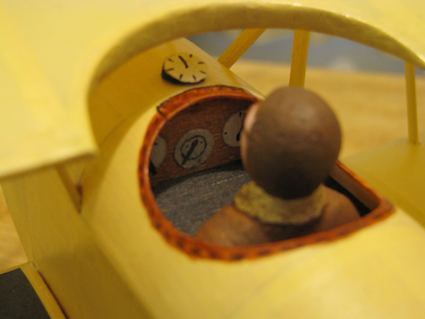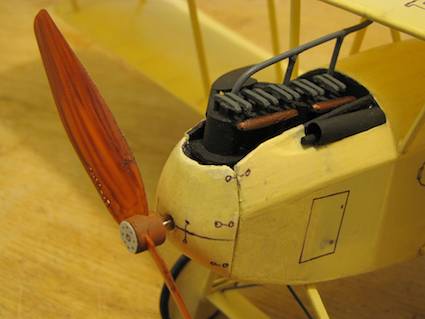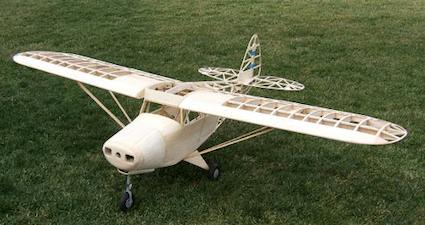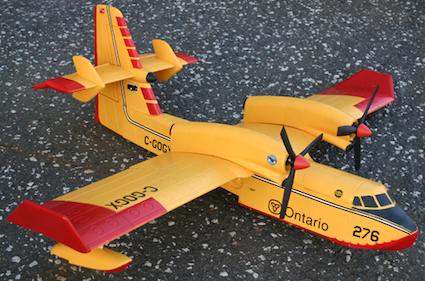 |
Flying High With Electric Power!
The Ampeer ON-LINE!
Fly the Future - Fly Electric! |
Site Table of Contents
| President: | Vice-President: | Secretary/Treasurer: |
| Ken Myers | Richard Utkan | Rick Sawicki |
| 1911 Bradshaw Ct. | 240 Cabinet | 5089 Ledgewood Ct. W. |
| Commerce Twp., MI 48390 | Milford, MI 48381 | Commerce Twp., MI 48382 |
| (248) 669-8124 | (248) 685-1705 | 248.685.7056 |
 | ||
| Board of Directors: | Board of Directors: | Ampeer Editor |
| David Stacer | Arthur Deane | Ken Myers |
| 16575 Brookland Blvd. | 21690 Bedford Dr. | 1911 Bradshaw Ct. |
| Northville, MI 48167 | Northville, MI 48167 | Commerce Twp., MI 48390 |
| 248.924.2324 | 248.348.2058 | 248.669.8124 |
| Mailed Ampeer printed subscriptions are no longer available.
The Ampeer is FREE on-line in Acrobat .pdf format and HTML with active links! | ||
| The Next Meeting:
Date: Saturday, May 5 Time: 10 a.m. (tentative) Place: First Flying Meeting of the year, Midwest RC Society 7 Mile Rd. Flying Field | ||
| What's In This Issue? | |
| Is a 50 a 50?, recommended power system for an 80 inch WS Canadair CL415 ARF | Keith Shaw Birthday Party Electric Fly-in 2012, upcoming meet announcement. |
| The March EFO Meeting, tornadoes, vacu-forming canopies & the Tactic AnyLink 2.4GHz Universal Radio Adapter | Keith Shaw's New, Little Halberstadt DV, details and photos of Keith's new indoor flier. |
| Belfort's Tri-Pacer Update, Don Belfort updates the construction of his Tri-Pacer. | Analyzing What You Read, Ken suggests that you put on your thinking cap while you are reading. |
| Upcoming Watts Over Wetzel, RCCD upcoming meet, May 19 & 20. | Upcoming Skymasters' Electrics' Over Lake Orion, Skymasters' upcoming E-meet. |
| Thayer Syme Joins 2 Brothers Hobby, What Thayer is up to now that he's no longer at Fly RC. | Bill Brown & Bill Shaftmaster Honored, a special night for Bill Brown (91) and Bill Shaftmaster (94)!. |
| Upcoming Mid-Am, flyer, map and hotels list for the 2012 Mid-America Electric Flies. | |
|
From Robert Fishwick via email Vancouver, Canada Hello Kenneth, I have had my eye on an 80 inch WS Canadair CL415 ARF for some time now. I have loved this aircraft since the day, several years ago, when a friend and I sat on a mountain ridge and watched one scoop up water from the lake below and fly it down the valley where it dumped the load on a forest fire burning several miles away.
All the very best to you,
Hi Robert, As I am sure that you are aware, the name of the motor means absolutely nothing, no matter who the supplier is.
At 10 lb., 1000 watts in (100 watts in per pound) usually provides better than adequate performance, but since this plane will most likely be flying off the water, let's go with 1300 watts in or 650 watts in per motor. Using a 75% efficient power system indicates about 487.5 watts out. It appears that a 12" diameter prop should work, so an APC 12x8E should be about right. An APC 12x8E turning at about 8,850 RPM requires about 487 watts out. The pitch speed is about 67 mph. I prefer to keep the amp draw under 50 and greater than 25 on planes this size. This is how I figure the Kv for each cell count. 7S (3.7v * 7 = 25.9v under load) 650 watts in / 25.9v = 25 amps. I use a generic 2 amps as the no load amp draw of the motor, but some will be higher and some lower. 487.5 watts out / (25 amps - 2 amps) = 21.2 volts out. 8,850 RPM / 21.2 volts = 417.5 Kv For the Kv range I go up and down about 5% - 400Kv to 440 Kv. 6S (22.2 volts, 29.3 amps underload), (487.5 out, 27.3 amps out, 17.86 volts out) 8,850 / 17.86 = 495.5 Kv Range 470 Kv to 520 Kv 5S (18.5 v, 35.1 amps under load), (487.5 out, 33.1 amps out, 14.73 v out) 8,850 / 14.73 = 600 Kv Range 570 Kv to 630 Kv 4S (14.8 v, 43.9 amps under load), (487.5 out, 41.9 amps out, 11.63 v out) 8,850 / 11.63 = 760 Kv Range 720 Kv to 800 Kv Next I look at the weight range of the possible motors. I use 3 watts in per gram of motor weight as the lightest factor and 1.75 watts in per gram of motor weight as the heaviest. 650 watts in / 3 watts in per gram = 217g for the lightest motor and 650 watts in / 1.75 watts in per g = 371g for the heaviest to look at.
Ken |
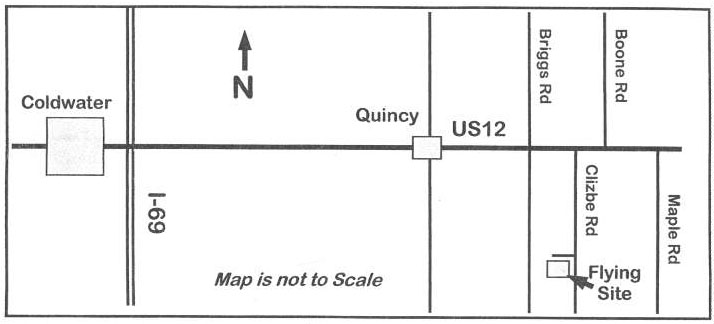
| The Balsa Butchers will once again be hosting the "Keith Shaw Birthday Party Electric Fly-In" at their field near Coldwater, MI. The event will take place on June 2 and 3, 2012.
Contest Director: Dave Grife - E-mail: grifesd@yahoo.com or Phone: 517.279.8445
The Flying Field will be open Friday, June 1 for early arrivals
The March EFO Meeting The March 15 EFO meeting was held at Ken's house. It was a night of severe thunderstorms, giant hail and tornadoes here in southeastern Michigan. A few brave souls managed to make it to the meeting. 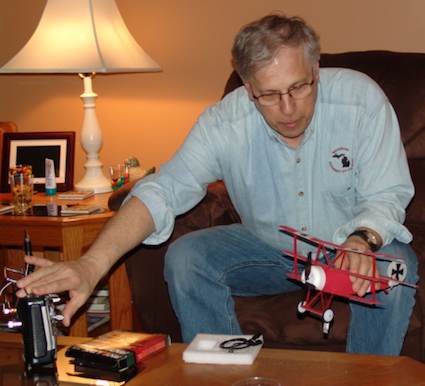 Roger Wilfong brought along his new Tactic AnyLink 2.4GHz Universal Radio Adapter (www3.towerhobbies.com/cgi-bin/wti0001p?&I=LXBPKF&P=ML) which came FREE with his Hobbico Fokker Dr.1 Micro EP Tx-R 14.1" (www3.towerhobbies.com/cgi-bin/wti0001p?&I=LZ1272&P=M) . It does NOT require the Futaba, Hitec, JR and Spektrum brand radios to have an RF module, as the AnyLink attaches to the back of the transmitter via an "industrial grade" type hook-and-loop fastener. Futaba and Hitec transmitters must have trainer jack as the power is picked up via the trainer cord plug.
Next the vacuum forming machine was set up on the kitchen counter and Jim Young supervised and advised on the pulling of a canopy for Denny Sumner's LoPresti Fury and Ken's new, as yet unnamed twin. 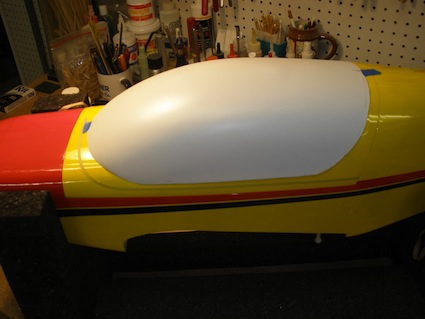 It took several tries to get some "good" canopies. Denny's successful canopy was pulled after a styrene version was pulled, as shown on the previous page. He used the styrene version to create a cutting template for his final canopy. 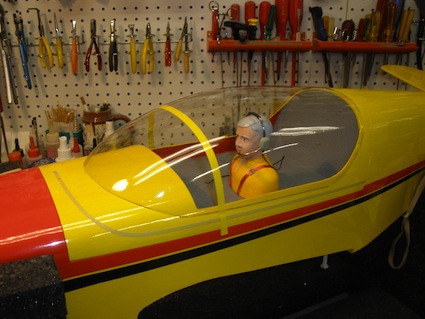 Both of the photos come from Denny's build thread on RC Groups.
Ken was not successful in pulling a clear canopy over a styrene version. For his final try, he "greased" the plug heavily with Vasoline. This produced a very usable version for him.
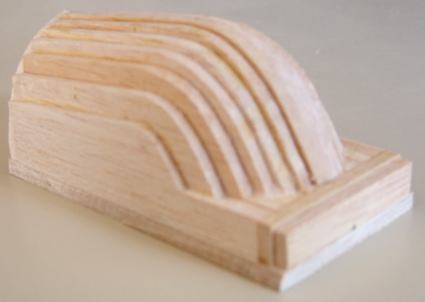 The photo shows Ken's canopy plug in rough form before sanding. It is made of 1/4" balsa cut to cross-section and then sanded to shape and filled with light-weight filler and sanded to final shape. 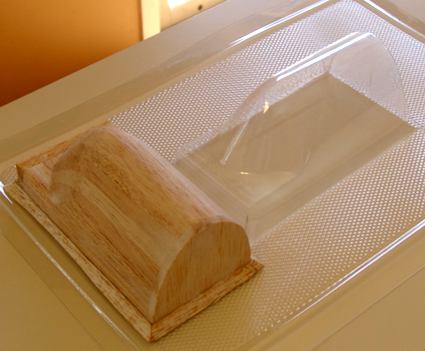 The meeting closed with refreshments and the video of the 15th Annual Mid-America Electric Flies.
Keith Shaw's New, Little Halberstadt DV
While Keith was recovering from his surgery, he had a bit of time to finish up this nifty little guy. This is from an email sent to many of his "followers". Thanks, Keith. KM I finished my small Halberstadt DV fighter. It has a 19" span and came out at 2.7 oz. I had to add 0.3 oz. of nose weight and carry a bigger 250 mAh cell to get it to balance, mostly due to the ridiculously long tail moment of this design.
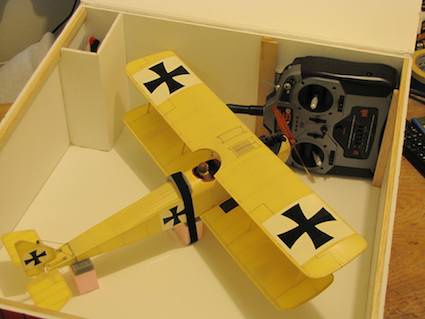
The first couple of short hops in the gymnasium were quite scary until I added the nose weight. It is much tamer now.
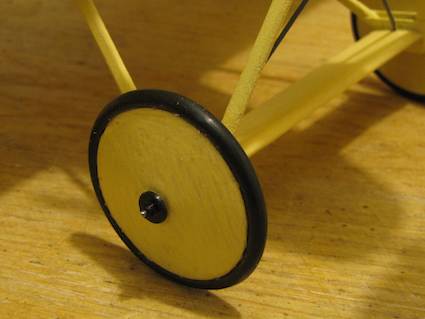 Also I had to make my own wheels as they are an odd size and/or too heavy. The wheels use an O-ring for the tire and weigh 0.1 oz each. I am hoping this good weather holds (mid-March KM) as I would like to fly it outside to get used to it and see what aerobatic potential is available. Apparently we set a high temp record almost every day I was gone (to the east coast KM). It was the same as on the east coast, several days were in the 80s. That's ridiculous for this time of year, we should still have 3-4 weeks of snow yet. Take care,
Belfort's Tri-Pacer Update
Hi Ken, Had a great time at E-Fest but now I need to get back to work on the Tri-Pacer to have it ready for the MidAm. Take care,
Looks like it is coming along very nicely. KM Analyzing What You Read
I never know how my day is going to go when I get up in the morning. I decided that I wanted to add as much data as I could garner from the "New" June 2012 Fly RC for my plane database.
Wingspan: 55in
I tried to see if the reported wing area was somewhat scale. Using information regarding the wing span and the fuselage length for the full-scale, I calculated that the model is about 1/20.5-scale. The full-scale has a wing of of 1080 sq.ft. An accurate 1/20.5-scale model would then have about 370 sq.in. of wing area.
Upcoming Watts Over Wetzel The Radio Control Club of Detroit is having their Watts Over Wetzel Electric Fly-in on May 19 & 20, contact Mike Pavlock (586)-295-3053 or email wattsoverwetzel@gmail.com
Upcoming Skymasters' Electrics' Over Lake Orion The Skymasters are also having a two day meet, June 9 and 10. The electric meet is on June 9 with a Pot Luck dinner at the field followed by night flying. Sunday June 10 will be Open flying with other Skymasters' members. The event starts at 10 a.m. on June 9 and will continue until Midnight. Contact Pete Foss email: petefoss@skymasters.org. For more information: www.skymasters.org/events/flyers/electricfly.pdf Thayer Syme Joins 2 Brothers Hobby Many of you know that Thayer is no longer editor of Fly RC and that Scott Stoops has also left Fly RC. Here is a press release from 2 Brothers Hobby & RC Flight Source. Thanks to Bob Aberle for the Press Release. Learn more at 2bfly.com KM RC editorial coverage expands on both web and mobile platforms COLUMBUS, OH; March 29, 2012 - We are very excited to announce that Thayer Syme has joined the 2 Brothers Hobby team as our Editor in Chief. In addition to the RC industry’s #1 ranked mobile app and our expanding web experience, Thayer and his team of Regional Editors will be bringing editorial features, build projects, product reviews, event coverage and even more rich media content to the 2BFLY and RC Flight Source platforms.
Kurt Gornek - 2 Brothers Hobby, LLC. - kurt@2bfly.com - 614-330-0397 About 2 Brothers Hobby, LLC. – Established in 2010, 2 Brothers Hobby is an independently owned and operated news and information resource, hosting the industry’s most comprehensive Knowledge Base on RC flight and are the software developers of the #1 industry ranked mobile application, RC Flight Source. Bill Brown & Bill Shaftmaster Honored
Bill Brown (far left), EFO member and Bill Shaftmaster were honored at the Pre-Horizon Toledo Meeting at the Ultimate Soccer Arenas on April 11. Joe Hass had cake and some very special early birthday surprises for these two active RC fliers. Bill Brown will be 91 this year and Bill Shaftmaster 94. We should all be active in the hobby for so long! Congratulations Gentlemen! The Upcoming Mid-Am, July 7 & 8, 2012 |
To Reach Ken Myers, you can land mail to the address at the top of the page. My E-mail
address is:
kmyersefo@theampeer.org
EFO WEB site: http://www.theampeer.org
